Thomas Krebs
Operetta Research Center
24 March, 2021
The story begins almost like a fairy tale: Once upon a time there were three brothers, George, Edward and John. They owned castles and married actresses – and lived happily ever after?
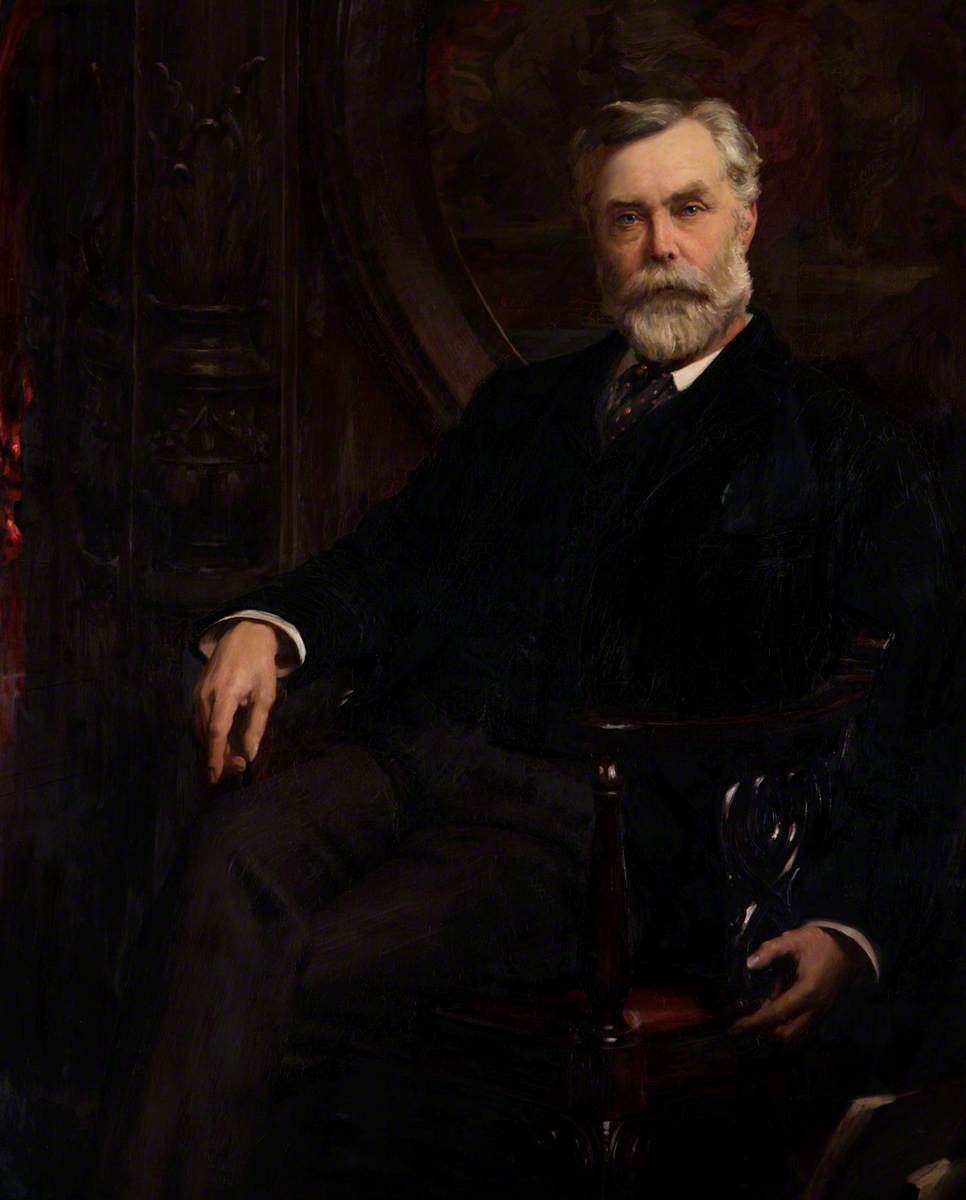
Industrialist John Bullough. (Photo: Scottish Natural Heritage)
Of course things are never as simple as that. There were three brothers and two half sisters, Bertha and Gladys. One of the brothers was called John, but known as Ian, he was half-brother to the two elder ones he married two actresses, Gaiety Girls Maudi Darrell and Lily Elsie. Edward did not own a castle and does not even appear on the family pedigree. He was, however, married to Enrichetta Checchi, the daughter of the great actress Eleonora Duse.
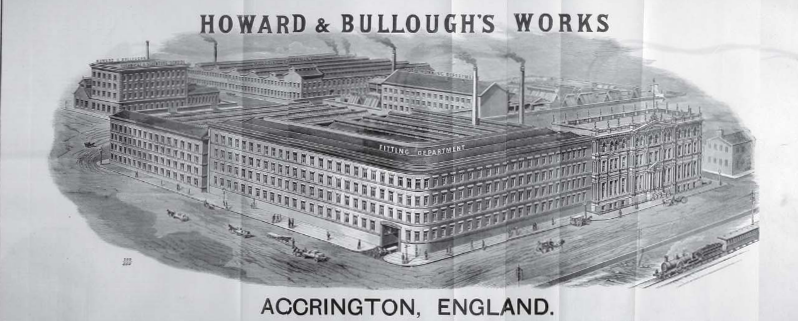
The Howard and Bulloughs Factory in 1892.
The father, Lancashire industrialist millionaire John Bullough, who had made his fortune with the cotton machinery manufacturers Howard & Bullough of Accrington, died in 1891, leaving one half of the share capital of the company (which would have over 6,000 employees by the 1920s) plus one estate each to two of his sons. George, the eldest, inherited the Isle of Rum in the Inner Hebrides, and he built Kinloch Castle there, as a lavish private residence and shooting lodge.

Kinloch Castle on the Isle of Rum. (Photo: Anne Burgess / Wikipedia)
Ian, the youngest, inherited the Meggernie estate in Perthshire with its 16th century castle. Edward got nothing, which may be due to the fact that John Bullough and his first wife Bertha were going through an acrimonious divorce when Edward was born in 1880.
Ian Bullough was the son of John Bullough with his second wife, Alexandra. He was born in Accrington in 1886 and grew up there and in Ireland, where his stepfather, John Beech, had property. Ian joined the Coldstream Guards in 1907. On his marriage to Maudi Darrell in March 1909 he had to leave the Guards as Guards were not allowed to marry actresses at that time.

Major Bullough and his later wife Lily Elsie. (Photo: lily-elsie.com)
The marriage plans had been kept secret, but the news of the wedding made the national and international newspapers. Here is what the Daily Mail of London had to say:
Miss Maudi Darrell Wedded to Son of a Rich Manufacturer
Miss Maudi Darrell, the musical comedy actress, was married yesterday afternoon to Mr. John Bullough, a gentleman of independent means. The news of the engagement had been kept a secret even from the members of “The Belle of Brittany” company, with which Miss Darrell had been appearing at every performance until the run came to an end at the Queen’s Theatre last Saturday night.
Yesterday, about noon, Mr. Bullough, who has been staying at the Ritz Hotel, called at Miss Darrell’s house, 7, Somers Place, Cambridge Square, W., and together in a taxicab they drove to the Paddington Registry Office, Harrow Road, where they were married. The only other persons present at the ceremony were the Bride’s father, Mr. Hugh J. Didcott, who is a theatrical and music-hall agent, and a lady friend, who acted as a witness.
The bridegroom, a tall, clean-shaven young man, twenty-three years of age, who gave his address as the Ritz Hotel, is a son of the late Mr. John Bullough, a very wealthy Accrington manufacturer, and a half-brother of Sir George Bullough, of Kinloch Castle, Isle of Rum, Argyllshire. Miss Maudi Darrell’s slight figure and pretty face have become familiar to theatre-goers through the many parts she has played in successful musical comedies since she first went on the stage, in her seventeenth year, as one of the six little wives in “San Toy” at Daly’s Theatre, nearly ten years ago. She had only just left school – the Sacré Cœur Convent, Paris. Her advancement was fairly rapid, for in less than three years she got an opportunity to play a good part in “The Toreador” at the Gaiety Theatre. Then followed a series of successes.
(The lady friend was Elizabeth Morice, wife of Hugh Didcott and Maudi’s stepmother.)
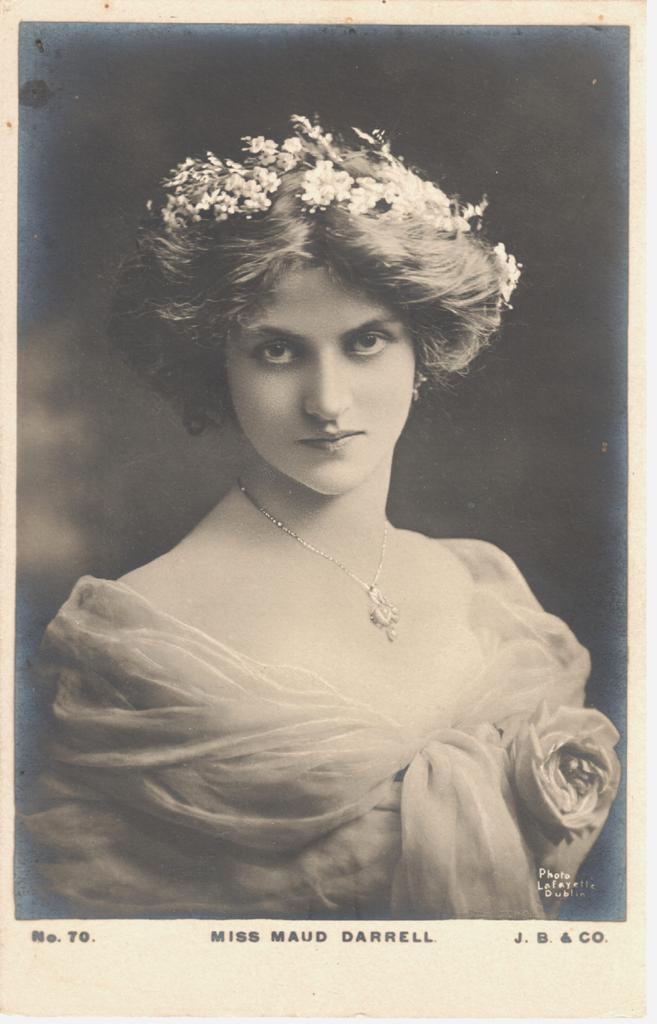
Miss Maud Darrell photographed by Lafayette, Dublin. (Photo: Thomas Krebs Archive)
Maudi was in fact two years older than was stated on her marriage certificate. She was born Maude Rhoda Didcott on 10th February 1880 at 16 Waterloo Road, Lambeth. Her father was Hubert Tay Morice, comedian and theatrical agent, who had started using the nom de plume Hugh Jay Didcott in the 1870s (he was a colorful character who had various names and was married, widowed and divorced more than once). Her mother was Emily Fleming, a ballet dancer who specialized in skipping rope dancing and appeared under the stage name of Miss Rose Fox and her company of Belles Blondes. She died in 1889. Hugh Didcott survived her by 20 years.
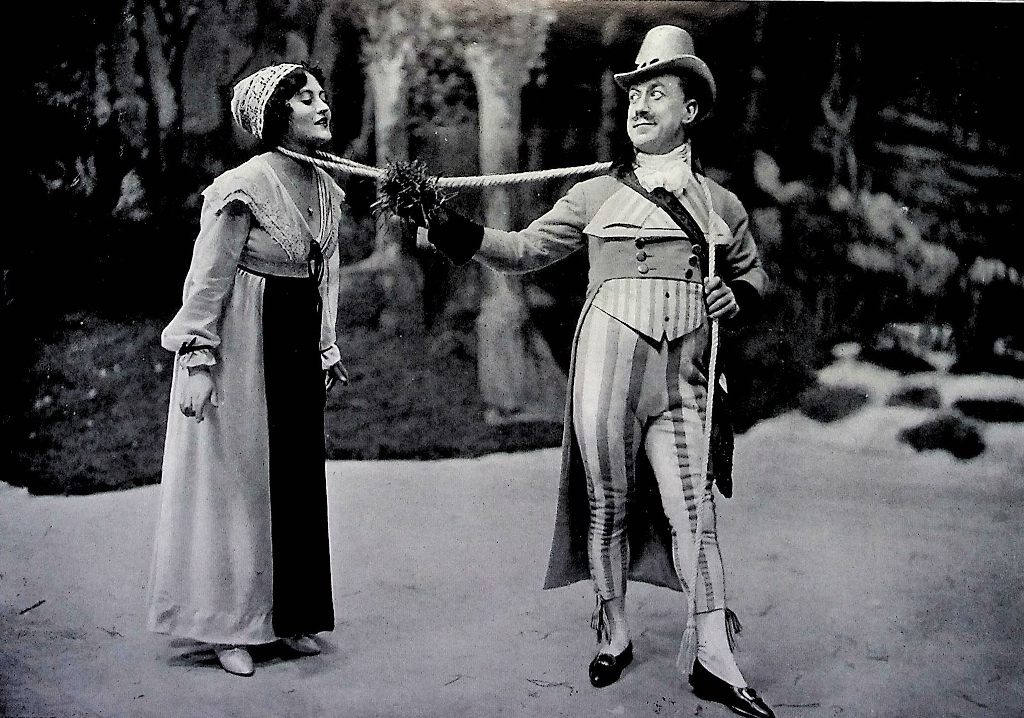
Maudi Darrell in “an amusing ‘action’ duett” (“Two Giddy Goats”) from “The Belle of Brittany,” as seen in “The Playbill Pictorial.” Her partner is Mr. Walter Passmore as Baptiste Boubillon to her Toinette. (Photo: Thomas Krebs Archive)
In The Gaiety Stage Door – Thirty Years’ Reminiscences of the Theatre (1923) James Jupp, stage door-keeper at the old and new Gaiety for more than thirty years, paints this loving portrait of Maudi Darrell:
In my collection of photographs is one beautiful girl, dainty of build, vivacious of manner, and of a fascinating personality, Maudi Darrell. She was about seventeen when she first came to the Gaiety. Like Mabel Russell and many other girls who won success under George Edwardes, Maudi Darrell was practically unknown when the “Guv’nor” gave her the first contract. There never was a theatrical man equal to George Edwardes in divining the possibilities of a little-known or obscure artist.
Maudi Darrell was the daughter of the music-hall and theatrical agent, Hugh J. Didcott, but although for the sake of an old friend the “Guv’nor” consented to see and hear Maudi, he would never have given her an engagement at the Gaiety if he had not been convinced that she was talented. Maudi Darrell was born for the stage. She could dance as well as sing and it was not long after I had checked her through for the first time that I realized the new-comer was to be the rage of the season. I never knew a girl more full of life. Laughter and she were twin sisters. Maudi was bubbling over with gaiety and high spirits as much after a long, wearisome rehearsal as when she passed by the stage-door on her way in. Rather dark, Maudi was always neat and smart, and after her promotion from show girl to song and solo dance, she became the talk of the town.
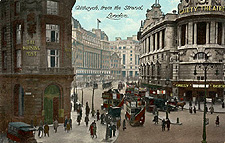
The Gaiety Theatre in London, 1905.
The box office was crowded out with West End swells, eager to buy stalls where they could come within range of her sparkling eyes and under the witchery of her twinkling feet. Every night my office was packed with floral tributes and gifts representing a small fortune. I remember handing over to her one night a huge floral tribute principally composed of orchids, at that season most expensive, built up like a castle, and as she knelt down to read the card which bore the signature of a Duke, I thought what a pretty picture she made.
I packed this magnificent gift and a score of others into her motor-car that night, and as she sang out in that bright manner which made her beloved by so many, “Good night, Jupp,” and threw a kiss, I wished that I were an artist to paint the lovely picture she presented.
Productions in which Maudi Darrell performed include Robinson Crusoe, apantomime, at the Princes Theatre, Manchester, in January 1903. The Guardian had this to say:
Miss Maudi Darrell, the new principal girl, is a bright and attractive actress, and introduces a new song, ‘The Rose of the Riviera’, which is now enjoying great popularity at Drury Lane. The song is worked on the ‘Tell me, pretty maiden’ lines, the principal vocalist being accompanied by a group of Riviera dandies and by a second group of little girls, and it is altogether a pleasant incident—one of the many with which the pantomime is liberally studded.
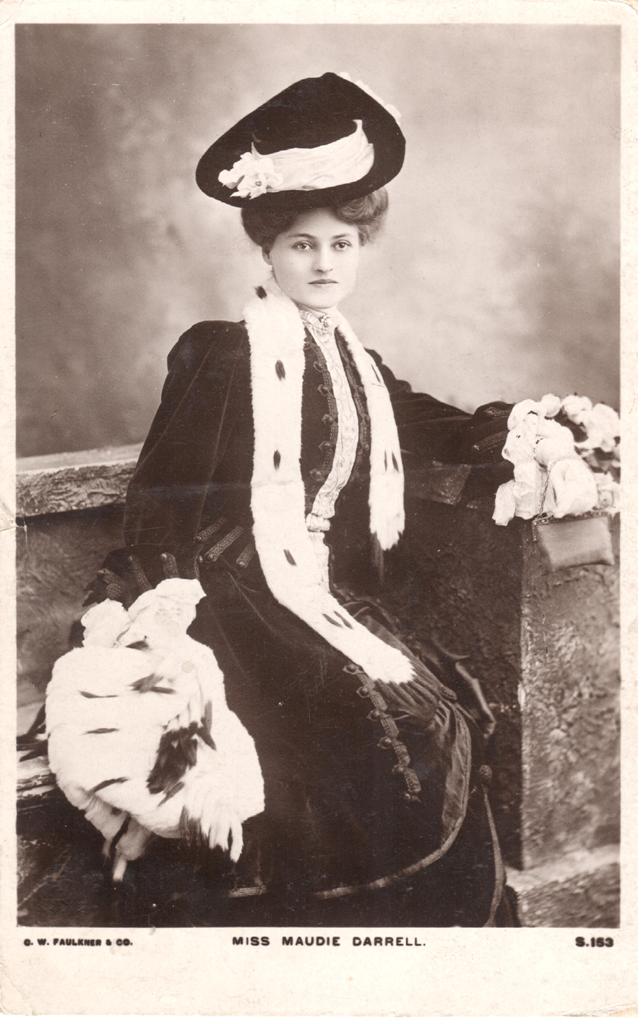
Maudi Darrell photographed by C. W. Faulkner. (Photo: Thomas Krebs Archive)
Then, there was Véronique by André Messager at the Apollo Theatre in London in 1903/04 with the following cast: Mesdames Lena Maitland, Kitty Gordon, Sybil Grey, Maudi Darrell as Denise, Lulu Valli, Hilda Corral, Tilly May and Ruth Vincent; Messrs. Lawrence Rea, Fred Emney, Aubrey Fitzgerald, Akerman May, Henry Adnes, Bernard Dudley, and George Graves.
A year later, in 1905, there was The Talk of the Town, a musical comedy by Seymour Hicks at the Lyric Theatre, London, withMaudi Darrell wearing the Gown of the Season.
In March 1906 The Beauty of Bath followed, a musical comedy by Seymour Hicks and Cosmo Hamilton with lyrics by C. H. Taylor and music by Herbert Haines. It premiered at the Aldwych Theatre. Maudi played Truly St. Cyr, an actress, and sang what was to become her signature tune: By the Side of the Zuyder Zee.
She also acted in non-musical productions, one of them being The Cassilis Engagement, a comedy by St. John Hankin, which was produced at the Imperial Theatre in February, 1907. The Daily Mail was grateful to Maudi in its review:
Luckily for some of us, Miss Maudi Darrell, of musical comedy fame, was the naughty Ethel, and extremely well she acted. A little too cattish, perhaps, but finished and clever. Her pantomime song was the brightest touch of a very dull afternoon, though we should not like Mr. Hankin to hear us saying that.
Her last appearance on the stage before her marriage was in The Belle of Brittany with music by Howard Talbot and Marie Horne, which premiered at the Queen’s Theatre, London in October 1908. The Globe announced the show on 14 October 1908:
Miss Maudi Darrell, who is to create a leading part at the Queen’s on Saturday, first appeared as one of the “six little wives” in “San Toy” in 1899. She has been mostly associated with musical comedy, but most theatre-goers will remember with what success she succeeded Miss Billie Burke in the leading part in“Mrs Ponderbury’s Past” last year. She is an extremely good woman of business, and takes the liveliest interest in all public affairs.
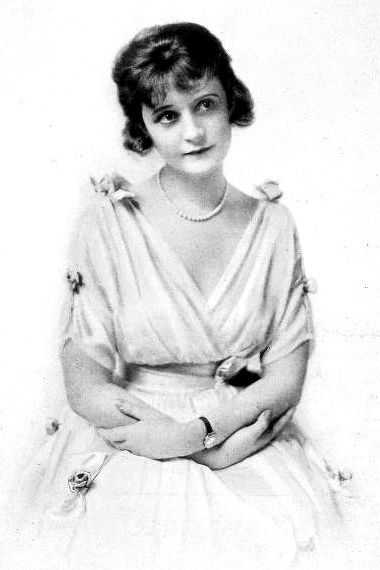
Billie Burke in 1916. She married Florenz Ziegfeld and was to play the good Witch Glinda in the 1939 MGM movie “The Wizard of Oz.” (Photo: The Photo-Play Journal)
The Sphere devoted a full page to a review by one J.M.B. that was not altogether enthusiastic, but did have praise for Maudi:
It is not that one clamours for high art. One asks only for catchiness, and in the present instance Mr. Talbot’s craft has deserted him and he gives you nothing to hum as you leave the house. […] Miss Maudi Darrell plays the part of the maid with immense zest; indeed, she always takes such an interest in her work that she wins her way to your sympathies.
After her marriage, she retired from the stage, a move that was deplored in the Philadelphia Inquirer:
Mrs Bullough […] was to have played in “The Devil”, at the Adelphi. Mrs Bullough has announced her intention of leaving the stage for good and all, and will not even appear at charity matinees, the stage loses a popular actress by her marriage.
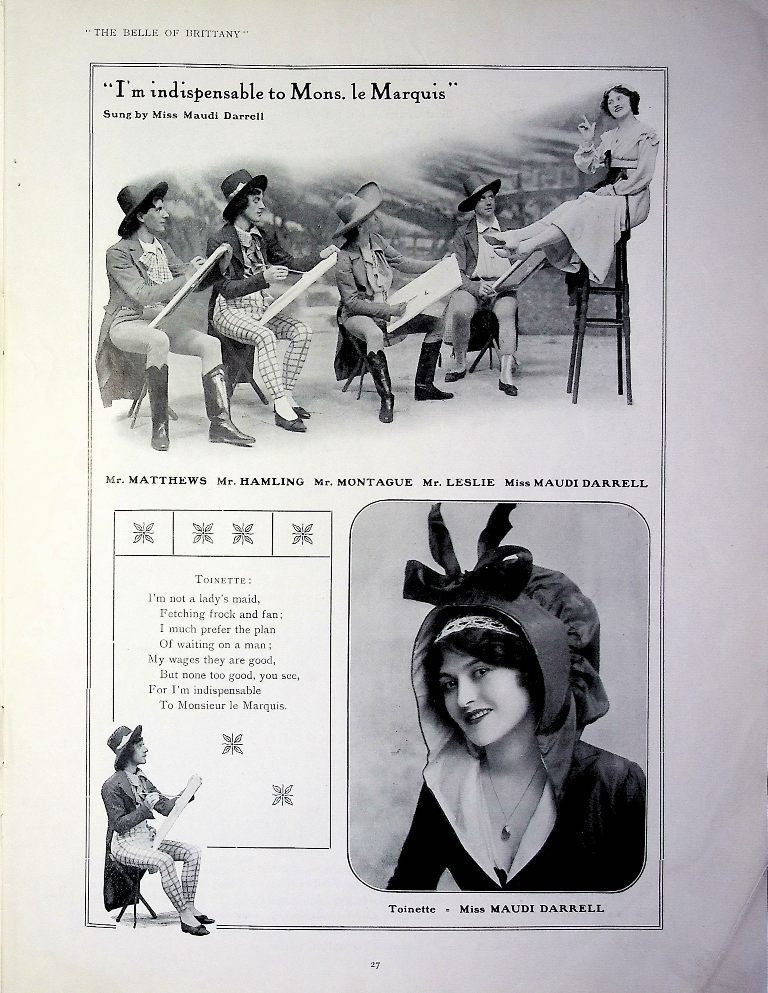
Maudi Darrell singing “I’m indispensible to Mons. le Marquis” to Mr. Matthews, Mr. Hamling, Mr. Montague and Mr. Leslie in “The Belle of Brittany.” (Photo: Thomas Krebs Archive)
How popular and well-liked she was is also apparent in an article in Pearson’s Weekly with the headline “Putting Petticoats on Stars,”from 18 April 1912:
Lily Elsie knows just what Dresses she wants, but many Actresses give Infinite Trouble.
This article has been written by the head of a well-known firm of modistes who have made the costumes for the leading ladies in many theatrical productions. The easiest actress to dress was the late Miss Maudi Darrell, who always knew exactly the sort of dresses she wanted, and never made any difficulty about trying them on. I believe Miss Lily Elsie was also a very easy actress to dress.
Maudi Bullough was not to enjoy married life for long. She fell ill after a few months and died the following year, on 31 October 1910.
In the second part of his reminiscences of Maudi, James Jupp describes her last visit to the Gaiety Theatre:
I did not imagine then, and she did not imagine, that the time would come when, knowing that her end was near, the incomparable Maudi Darrell, the one-time darling of the stage, would leave her husband’s estate in Scotland, and broken and ill as she was, would travel down to London, and that I should carry her from her carriage, drawn up outside the stage-door, to a private box, that she might look for the last time upon that Gaiety stage where no star in the theatrical firmament had shone more brightly than she.
I did not see Miss Darrell for a long time after she was married to Ian Bullough. One day we heard that the former Gaiety favourite was ill. Weeks went by, and the reports concerning her became more serious.
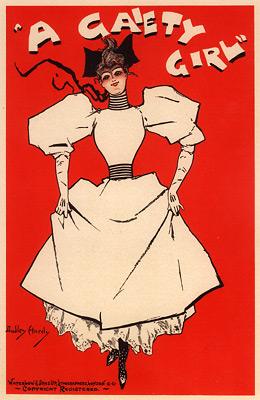
Dudley Hardy lithograph poster for “A Gaiety Girl” from “Les Maitre de L’Affiches” series, 1896.
I was standing at the stage-door one afternoon some time before the evening performance was due, thinking of nothing in particular, when a car drove up and stopped a few yards away. I walked towards it, and saw that the occupant was none other than Maudi Darrell—but what a change! Maudi the vivacious, the actress who set all London alight, and had once been the brightest star in the theatrical firmament, was lying full length in the car, and upon her face had crept shadows of impending death. She must have been very weak and in pain; but when she saw me she smiled, and even in her agony the smile had not lost its sweetness.
“This is the last time I shall come to the old theatre, Jupp,” she said.
We carried her from her carriage to a box, and although very few members of the audience recognized in the invalid woman the star of other days, the members of the company knew of her presence, and the show that night was played for the benefit of Maudi Darrell.
She remained to the end, and then with one long last lingering look she bade farewell to the scenes of her former greatness.
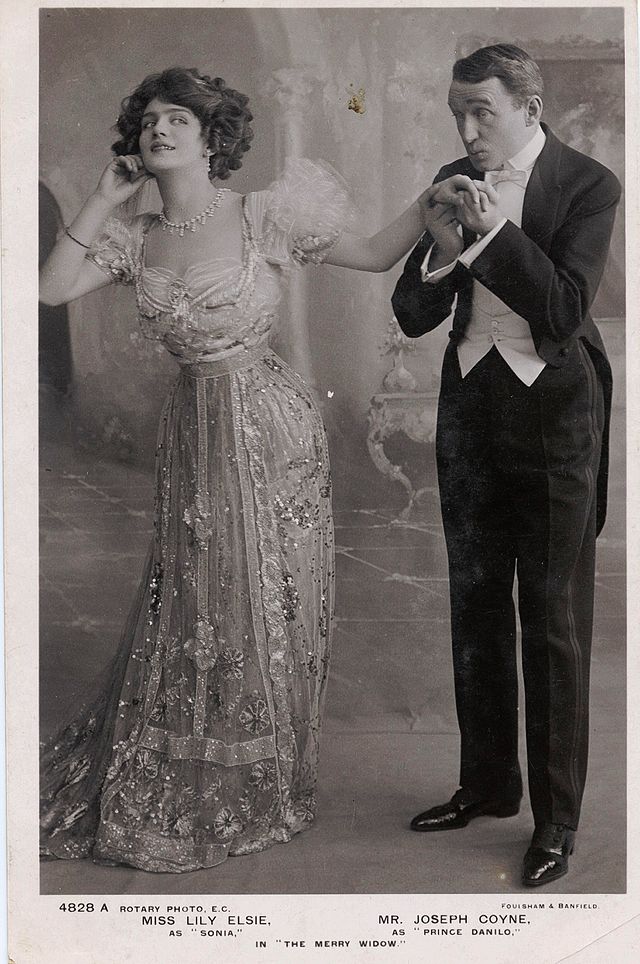
Lily Elsie and Joseph Coyne in “The Merry Widow.” In its English adaptation by Basil Hood, with lyrics by Adrian Ross, the show became a sensation at Daly’s Theatre in London, opening on 8 June 1907.
Almost exactly a year after her death, Maudi’s widower, Ian Bullough, married Lily Elsie. She too became ill quite soon afterwards, and there were rumors in the newspapers that she was suffering from the same condition as Maudi and was actually dying. (For more information on Lily Elsie, click here.)
The Washington Herald, in a full-page illustrated article from October 1915 about Lily Elsie’s return to the stage, even claimed Maudi and she were half sisters. In flowery language typical of the society pages of the time the article describes and compares the looks and beauty of the two stars:
Everyone in England agrees that Lily Elsie has the most kissable mouth in all England. Instead of the thin-lipped, too finely arched mouth, such as famous beauties have, she possesses the Cupid’s bow outline with the ends curving upward delicately, all ready for smiles. Her lips are full and ripely red, just naturally made to be kissed. […]
Maudi Darrell had one of those perfectly finished countenances which was as cold as Miss Elsie’s was warm.
I leave it to readers of this article to judge by the images provided whether or not Maudi Darrell’s beauty was cold. What we can glean from things written about her in papers and memoirs would suggest a charming, warmhearted personality who enjoyed life and died tragically young.
Let’s finish with what she had to say about her hobbies in The Royal Magazine in 1905: riding, driving, outdoor exercise, and foreign travel!
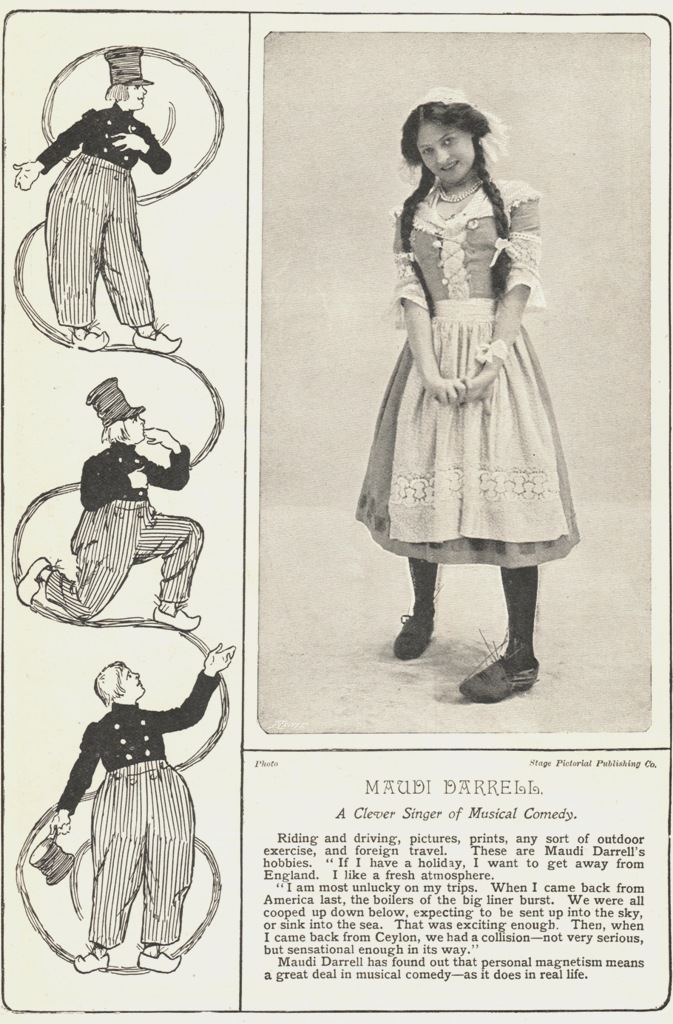
Maudi Darrell in “Dutch” attire as seen in “The Royal Magazine” in 1905. (Photo: Thomas Krebs Archive)

Hubert Jay Morice (né Morris Joseph, later Didcott)… fascinated to know where “Emily Fleming” came from. Didcott married Emily Mary Merryweather (1865, 2 children,divorced 1872.Did she also call herself “Fleming”? In any case, the Emily (born 1840, seen living with her children and parents in 1881) is surely not Rose Fox (born circa 1855 )who has just had a baby… Mr Didcott’s names and women are a bit of a puzzle.
Well, you’ve set me on a day-long trail to sort this one out.And I’ve done it. ROSE FOX was née Emily Rose FLEMING, daughter of Fred Fleming Liverpool last-maker who spent a decade as a comic on the halls.Mother Emma JACKSON. ‘Rose’ never married MORICE-DIDCOTT so their children were illegitimate, and Maudi was registered as both Maude Didcott and Maud Flem(m)ing. In fact, a year or so after Maude’s birth, MORICE married a dancer named Elizabeth BROWN(E) or ADLUM, another illegitimate sprog of another ballet-dancer … Btw his first wife quoted four co-respondents … invluding one well-known dancer. Seems Diddy was one of those chaps who fancied little ballet girls.
Thanks for the lead! That one had been sitting 20 years in the ‘to do later’ box!
Interesting ephemera: In the 1891 census, Diddy is sharing his home with … Rose’s mother Ellen née Jackson!!!! I guess the latest wife had gone the way of all the other? PS Daddy worked as Fred FOX. And sister Susan Gray FLEMING worked as Lily FOX. She became Mrs Poole (d 1915)
Thanks for sorting this out! Indeed, it’s not easy to keep track of Mr Didcott’ names and women.
Reynolds’s Newspaper, 27 May 1894, had a long report of a libel case brought by Hugh Jay Didcott (of York-road, Lambeth) against the editor of the ‘Pelican’:
‘Mr Didcott was the called and said he had been a music-hall agent for the best part of a quarter of a century, during a great portion of the time in York-road. He was sometimes known by the nickname of Mr. York Road. In the course of business a lady came to him about July or August, 1887. He obtained her engagements, and about 1891 she came to live with him as his wife, living with him till December 1893. He took a house near Gordon-square, furnishing it at his own expense, but taking it in the lady’s name […]
Mr Gill then quietly rose to commence a searching, not to say scorching, cross-examination. In reply to his questions Mr Didcott said he had been known as Maurice Joseph, Hubert Jay Maurice, and Hubert Jay Didcott. His real name was Maurice Joseph, and his father’s name was Jude Joseph.
[.…] Mr Gill: Then we will try your different marriages. You were married in 1863 in the name of Maurice Joseph?—Complainant hesitated.
Come, Mr. Didcott, you must remember something. (A laugh.) —I will answer you if you will give me time.
But you were not married every day, were you? (Laughter.)
The Complainant then replied that he was married again in 1865, and was divorced in 1888 on the ground of cruelty and adultery. He was not aware that the charges against him were that he had horsewhipped his wife and given her jewellery to the lady he was living with.
He had lived with a lady in Stamford-street, but it was not necessary to mention her name any more than it was necessary to mention the name of the lady in the present case. He was again married in 1888. […]
Cross-examination resumed. His two last wives were still living.’